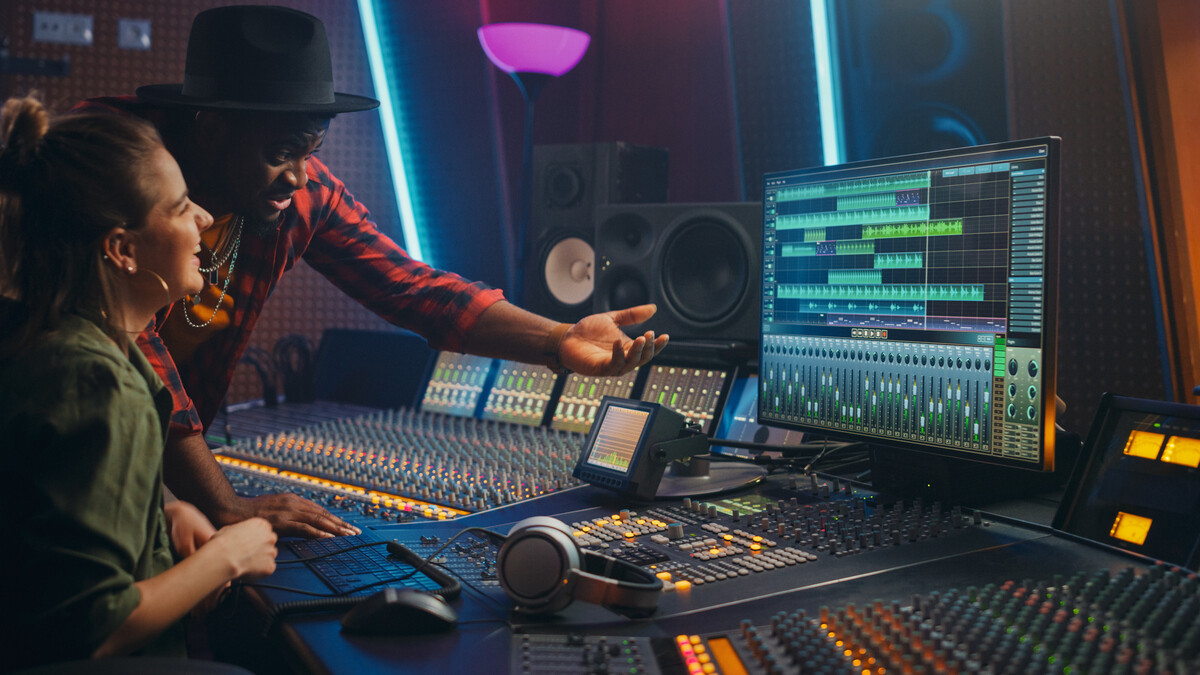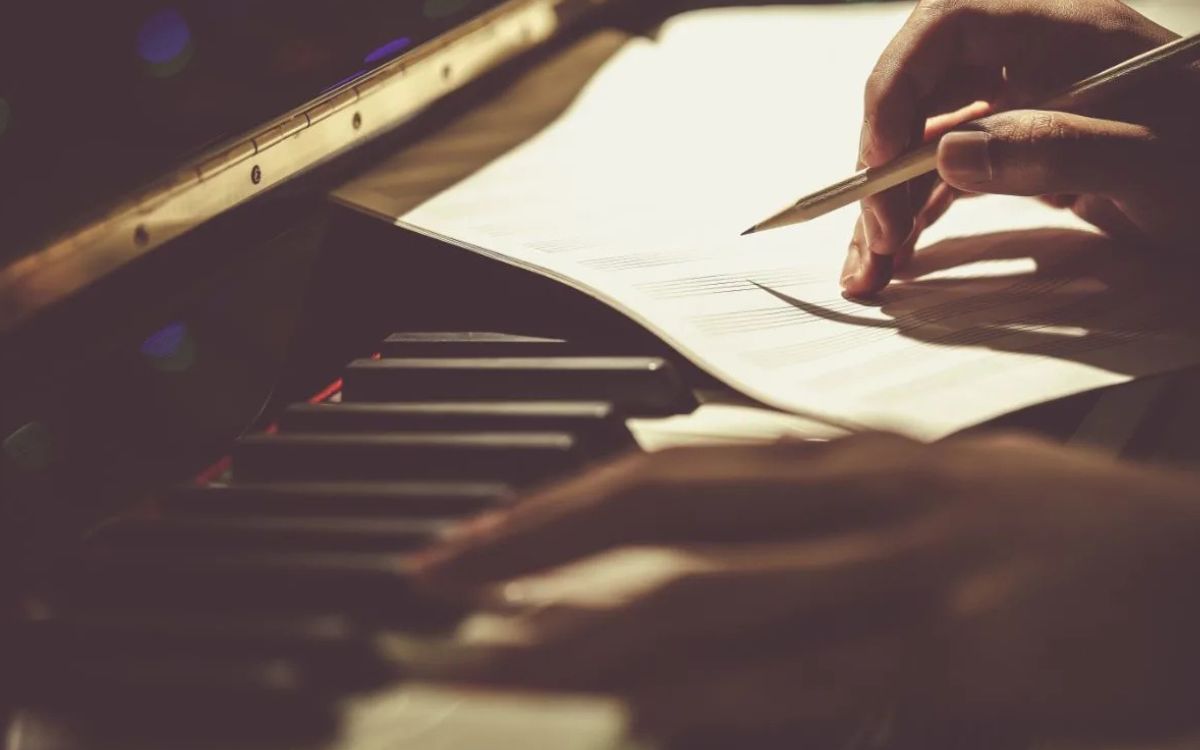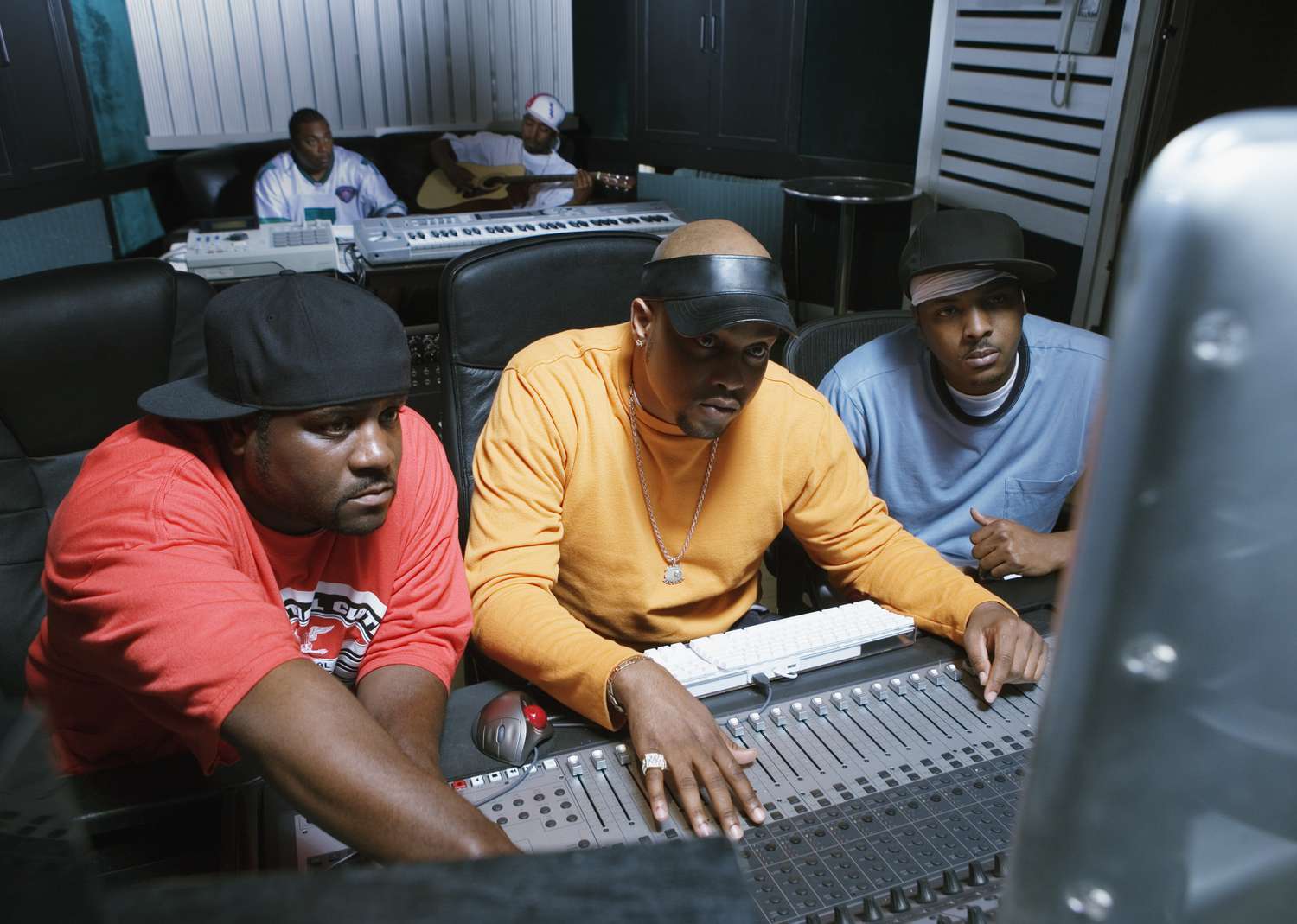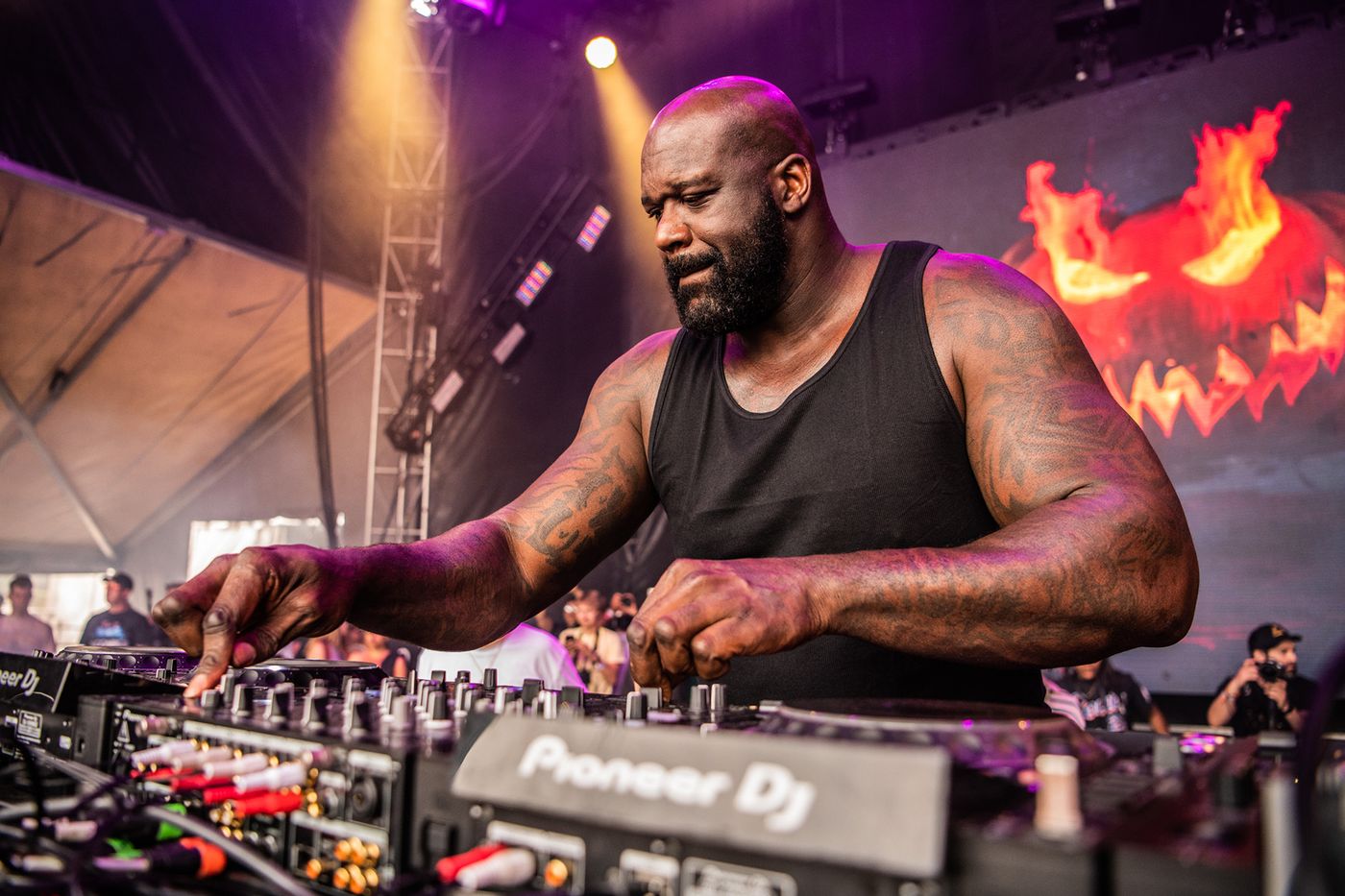Home>Production & Technology>Composer>What Does A Composer Do When Orchestrating A Piece Of Music
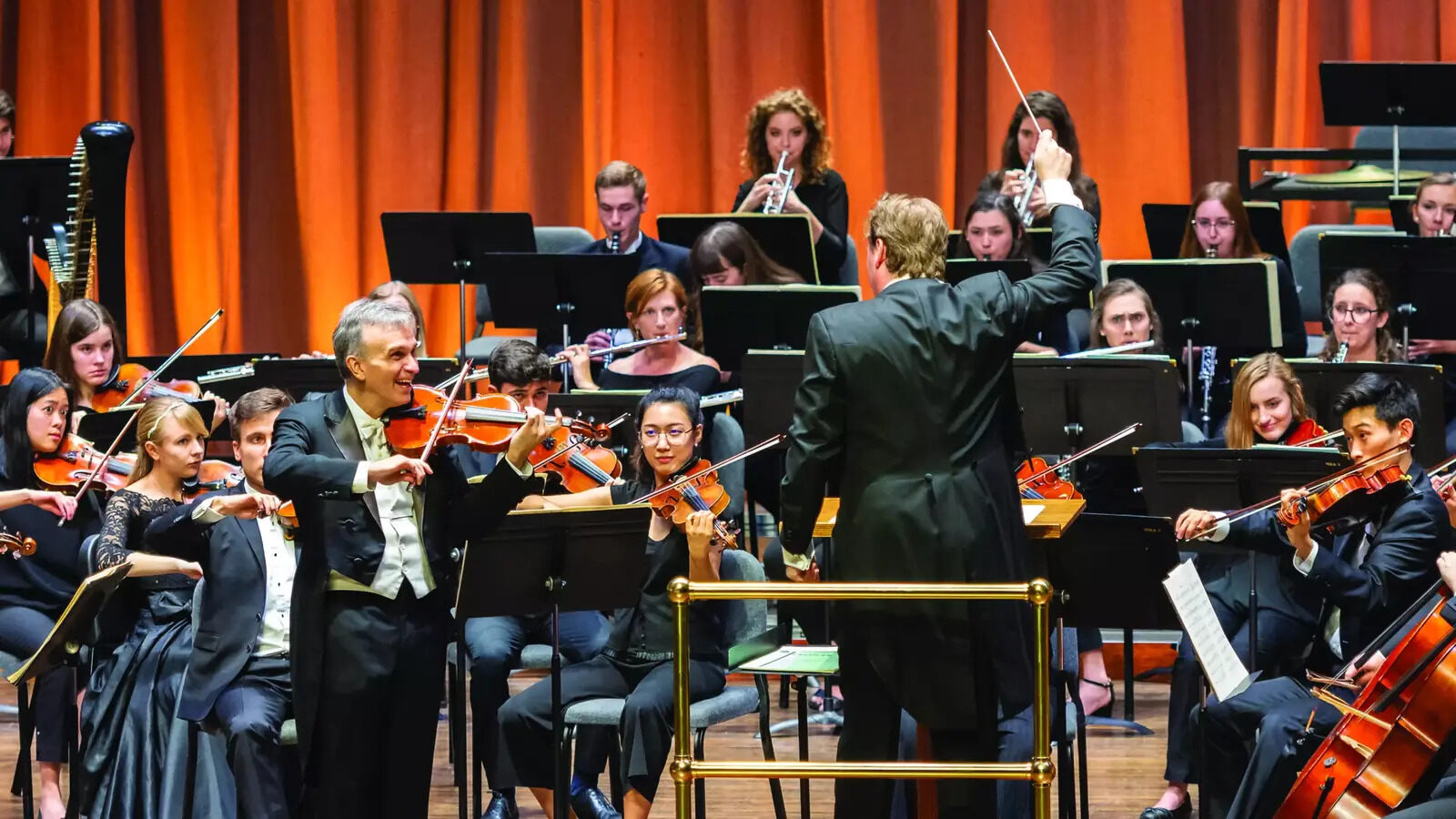

Composer
What Does A Composer Do When Orchestrating A Piece Of Music
Modified: February 24, 2024
Discover the role of a composer when orchestrating a piece of music. Learn how composers bring their musical vision to life through composition and arrangement.
(Many of the links in this article redirect to a specific reviewed product. Your purchase of these products through affiliate links helps to generate commission for AudioLover.com, at no extra cost. Learn more)
Table of Contents
- Introduction
- Overview of Music Orchestration
- Role of the Composer in Orchestration
- Selecting Instruments
- Assigning Parts to Instruments
- Balancing and Blending Sounds
- Creating Harmonies and Counterpoint
- Enhancing Dynamics and Expressiveness
- Notating the Orchestral Score
- Collaborating with Conductors and Performers
- Conclusion
Introduction
Music orchestration is a fascinating art form that brings together various instruments to create a harmonious and expressive composition. At the heart of this creative process is the composer. A composer not only writes the music but also plays a pivotal role in orchestrating it to bring out the desired emotions and impact.
In this article, we will explore the essential role of a composer in orchestrating a piece of music. We will delve into the intricacies involved in instrument selection, assigning parts, balancing and blending sounds, and creating harmonies and counterpoint. We will also examine how composers enhance dynamics and expressiveness, notate the orchestral score, and collaborate with conductors and performers.
By understanding the composer’s role in orchestration, we gain a deeper appreciation for the artistry and skill required to bring a musical composition to life. So let’s dive in and uncover the secrets and challenges that composers face when orchestrating a piece of music.
Overview of Music Orchestration
Music orchestration is the process of arranging a piece of music for an orchestra or ensemble. It involves selecting the instruments, assigning parts to each instrument, and determining how they work together to create a cohesive and impactful sound. Orchestration requires a deep understanding of each instrument’s capabilities, tonal qualities, and expressive possibilities.
The purpose of orchestration is to bring out the full potential of the composition, highlighting its melodies, harmonies, and textures. The composer’s goal is to create a balanced and expressive orchestral arrangement that captures the essence of the music and evokes the desired emotions in the listeners.
When orchestrating a piece of music, the composer considers various factors such as the genre, style, and mood of the composition. Different genres may call for different instrument combinations – from classical symphonies with strings, woodwinds, brass, and percussion, to jazz ensembles with saxophones, trumpets, pianos, and drums. The composer also takes into account the technical abilities of the performers who will be playing the music.
Additionally, the composer must be mindful of the sonic balance between the instruments. Certain instruments naturally project louder or softer sounds, and the orchestrator must find ways to ensure that no instrument dominates the overall sound. This involves carefully assigning the parts to instruments and adjusting the dynamics to achieve a cohesive and well-balanced orchestration.
Furthermore, orchestration involves creating harmonies and counterpoint. The composer selects which instruments will play the melody, harmony, or counterpoint lines, and arranges them in a way that complements and enhances the overall musical texture. This requires a deep understanding of musical theory and the ability to create intricate and compelling musical interactions.
In the next sections, we will explore in detail the specific tasks and techniques that composers employ when orchestrating a piece of music. From choosing the instruments to collaborating with performers, each step in the orchestration process plays a crucial role in shaping the final musical product.
Role of the Composer in Orchestration
The composer plays a pivotal role in the orchestration process, serving as both the creative visionary and practical coordinator. They are responsible for translating their musical ideas into a tangible and coherent orchestral arrangement. Let’s explore the key aspects of the composer’s role in orchestration.
First and foremost, the composer selects the instruments that will be used in the orchestration. This decision depends on various factors such as the desired sound palette, the genre of the composition, and the emotions they aim to evoke. Whether it is the warm and expressive tones of a string section or the bold and powerful brass instruments, the composer carefully considers which instruments will best bring their musical vision to life.
Once the instruments are chosen, the composer assigns specific parts to each instrument. This involves determining which instruments will play the melody, harmony, or even solo passages. The composer must take into account the technical abilities and range of each instrument, ensuring that the parts are playable and showcase the strengths of the performers.
A crucial aspect of the composer’s role in orchestration is balancing and blending the sounds of the instruments. They must carefully consider the relative volumes and timbres of each instrument to achieve a cohesive and pleasing overall sound. This requires careful attention to dynamics, adjusting the loudness and softness of the individual instrument parts to create a well-balanced and expressive orchestration.
In addition to balancing the sounds, the composer is also responsible for creating harmonies and counterpoint. They decide which instruments will play the chords, creating lush harmonies, and which instruments will take on counterpoint lines to add depth and complexity to the composition. This skillful interplay of different musical lines is a hallmark of great orchestration and highlights the composer’s mastery of musical texture.
Furthermore, the composer enhances the dynamics and expressiveness of the orchestration. This entails determining when certain instruments should be prominent or understated, and when to introduce crescendos and decrescendos to create tension and release. Dynamic markings on the score guide the performers in bringing the intended emotions and energy to the music.
Notation is another important aspect of the composer’s role in orchestration. They must accurately notate the orchestral score to ensure clear communication with the performers. This involves writing out the musical details such as melodies, harmonies, dynamics, articulations, and phrasing, so that the musicians can bring the composition to life accurately.
Lastly, the composer collaborates with conductors and performers to bring their orchestral vision to fruition. They work closely with the conductor to communicate their intentions and guide the interpretation of the music. The composer also engages with the performers, providing guidance and feedback to ensure the desired interpretation and emotional impact are achieved.
The role of the composer in orchestration is multi-faceted and requires a deep understanding of musical elements, instrument capabilities, and the ability to translate ideas into a cohesive and expressive orchestral arrangement. The composer’s artistry, creativity, and technical expertise are crucial in shaping the final sonic landscape of a composition.
Selecting Instruments
One of the first and most crucial tasks for a composer in orchestration is selecting the instruments that will be used in the arrangement. The choice of instruments greatly influences the overall sound and character of the composition. Let’s take a closer look at the factors involved in selecting instruments.
The genre and style of the composition play a significant role in determining which instruments are most appropriate. For example, a classical symphony may involve a full orchestra consisting of strings, woodwinds, brass, and percussion, while a jazz piece might focus on a smaller ensemble of saxophones, trumpets, pianos, and drums. The composer considers the genre and desired mood of the music to choose instruments that will best convey the intended emotions and atmosphere.
The tonal qualities and expressive capabilities of each instrument are also important considerations. Each instrument has its unique characteristics and range of expression. For instance, a violin can produce a wide range of dynamics with its bowing techniques, while a trumpet has a bright and piercing sound. The composer selects instruments that will effectively convey the desired emotions and musical ideas.
Another factor in instrument selection is the technical ability of the performers who will be playing the music. Not all musicians are proficient in playing every instrument, so the composer must consider the skill level of the ensemble or orchestra that will be performing the piece. This ensures that the selected instruments are within the performers’ capabilities, allowing them to execute the music accurately and expressively.
Instrument combinations also play a significant role in orchestration. Certain instruments naturally blend well together, creating a balanced and harmonious sound. The composer explores different instrument combinations and experiments with their interactions to find the most effective orchestral palette for their composition. This may involve considering the blending qualities of similar instruments, such as the different members of the woodwind or brass families, or contrasting instruments to create rich and dynamic textures.
While traditional orchestration often follows standard instrumentations, composers also have the freedom to explore unconventional or innovative instrument choices. This can add unique and captivating elements to the composition and result in fresh and exciting sounds. However, it is important to strike a balance between experimentation and practicality to ensure that the chosen instruments can effectively convey the intended musical ideas.
Overall, selecting the right instruments is a crucial step in the orchestration process. It involves considering the genre, style, tonal qualities, expressive capabilities, and technical abilities of the performers. By carefully choosing the instruments, composers can create a captivating and expressive orchestral arrangement that brings their musical vision to life.
Assigning Parts to Instruments
Once the composer has selected the instruments for the orchestration, the next step is to assign specific parts to each instrument. This task requires careful consideration of the musical elements and the capabilities of each instrument. Let’s explore the process of assigning parts to instruments in more detail.
The melody is often a focal point in a composition, and the composer decides which instruments will carry the melody. This can be a single instrument, such as a violin or a flute, or it can be shared across different sections or instruments for a more layered and dynamic effect. The choice of instrument for the melody greatly impacts the overall character and timbre of the composition.
Harmony and accompaniment parts are another essential aspect of assigning parts to instruments. These parts support and enhance the melody by providing a harmonic foundation. Instruments such as the piano, guitar, or string section often take on these roles, creating the lush harmonies that complement the melody. The composer must consider the tonal qualities and capabilities of each instrument to ensure that the harmony parts blend harmoniously with the melody.
Counterpoint is an intricate technique in which multiple musical lines are played simultaneously, each with its independent melody. The composer decides which instruments will take on the counterpoint lines, creating rich and complex textures. This requires a deep understanding of musical theory and the ability to weave together various melodic lines to create a cohesive and harmonious composition.
Dynamics also play a role in assigning parts to instruments. The composer determines when certain instruments should be prominent or understated in different sections of the composition. This ensures that the parts are balanced and that the dynamics of the music effectively convey the intended emotions. For example, the composer may assign a soaring melody to the brass section for a powerful and expressive impact, while assigning a delicate accompaniment to the strings for a more subtle and sensitive tone.
Additionally, the composer considers the range and technical abilities of each instrument when assigning parts. They ensure that the parts remain within the playable range of the instrument, allowing performers to execute the music accurately and expressively. This requires a thorough understanding of each instrument’s capabilities and limitations.
Throughout the process of assigning parts to instruments, the composer maintains a balance between showcasing the strengths of individual instruments and creating a cohesive and well-balanced ensemble. They aim to highlight the unique qualities of each instrument while ensuring that they work together harmoniously to bring the composition to life.
By carefully and thoughtfully assigning parts to instruments, composers create a diverse and layered orchestration that maximizes the expressive potential of the ensemble. This process requires a deep understanding of musical elements, instrument capabilities, and the desired emotional impact of the composition.
Balancing and Blending Sounds
In music orchestration, achieving a balanced and blended sound is crucial to create a cohesive and pleasing overall texture. Balancing refers to adjusting the relative volumes of different instruments within the ensemble, while blending focuses on the tonal qualities and timbres of the instruments. Let’s explore the importance of balancing and blending sounds in more detail.
When orchestrating a piece of music, the composer must carefully consider the relative volumes of the instruments. Certain instruments naturally project louder or softer sounds, and it is essential to ensure that no instrument overwhelms or is drowned out by the others. The composer achieves this balance by adjusting the individual instrument parts, applying dynamic markings, and considering the overall dynamics of the composition.
Furthermore, the tonal qualities and timbres of different instruments contribute to the overall sound blend. The composer must ensure that the instruments work together harmoniously without one instrument standing out or clashing with the others. They achieve this by selecting instrument combinations that complement each other and by considering the specific registers and ranges of the instruments within the composition.
For example, in a string section, the composer might assign different parts to the various string instruments to achieve a balanced and blended sound. The violins may carry the melody, while the violas and cellos provide the accompanying harmonies. By carefully combining the instruments and managing the registers and dynamics, the composer creates a cohesive and blended overall sound.
The composer may also use techniques such as divisi and doubling to further enhance the blend. Divisi involves splitting a section of instruments into smaller groups, creating greater richness and depth in the sound. Doubling, on the other hand, involves assigning the same part to multiple instruments within a section, reinforcing and strengthening the sound.
Moreover, balancing and blending sounds require a keen ear for detail. The composer listens attentively to each instrument’s contribution and adjusts the parts as needed. This may involve rewriting certain passages, redistributing the musical material, or reassigning parts to different instruments or sections.
It is also important to note that not all parts within an orchestration need to be equally prominent. The composer strategically chooses when certain instruments or sections should take center stage or recede into the background, adding depth and dimension to the overall sound. This dynamic range contributes to the expressive qualities of the composition.
Ultimately, achieving a balanced and blended sound in orchestration requires a delicate interplay of volume adjustments, tonal considerations, and careful instrument arrangement. The composer’s keen sense of orchestral aesthetics and their ability to delicately sculpt the sound contribute to the overall impact and effectiveness of the composition.
Creating Harmonies and Counterpoint
Creating harmonies and counterpoint is a fundamental aspect of music orchestration. Harmonies add depth and richness to a composition, while counterpoint introduces complexity and interplay between different musical lines. Let’s explore the process of creating harmonies and counterpoint in more detail.
Harmony refers to the simultaneous sounding of different pitches or chords that support and complement the melody. The composer carefully selects the harmonic progression and chordal structures to create the desired emotional impact. They consider the tonal colors and relationships between chords to strike a harmonious balance.
When orchestrating harmonies, the composer decides which instruments will play the chords. This can be assigned to specific sections, such as the brass or woodwinds, or distributed across all sections to create a full and lush sound. The choice of instruments for the harmony parts influences the overall character and timbre of the composition.
Additionally, the composer may choose to incorporate suspensions, inversions, or other chordal alterations to add interest and tension to the harmonies. These techniques create unique and unexpected chord progressions that contribute to the overall expressive quality and musical color of the composition.
Counterpoint, on the other hand, involves the simultaneous interplay of multiple independent melodic lines. Each line maintains its own identity while interacting with and complementing the other lines. The composer carefully crafts the counterpoint to create a cohesive and balanced musical texture.
When orchestrating counterpoint, the composer assigns different melodic lines to various instruments or sections. These lines can weave together in a contrapuntal fashion, creating intricate and captivating musical interactions. The composer ensures that the counterpoint lines integrate harmoniously, enhancing the overall complexity and depth of the composition.
Counterpoint can take various forms, such as canon, fugue, or imitation. These techniques involve repeating or imitating melodic material across different instruments or sections, creating engaging and vibrant musical dialogues. The composer’s skillful handling of counterpoint adds layers of interest and complexity to the composition.
Furthermore, the composer may explore the concept of melodic doubling to strengthen the counterpoint. This involves assigning the same melodic line to different instruments or sections, reinforcing the musical idea and creating a rich and robust sound.
In orchestration, the combination of harmonies and counterpoint works hand in hand to create a dynamic and compelling musical landscape. The composer carefully balances these elements, ensuring that they enhance and support the melody without overpowering or distracting from it.
By creating harmonies and counterpoint, the composer adds depth, complexity, and texture to the orchestration. These musical elements contribute to the overall emotional impact and artistic expression of the composition, showcasing the composer’s command of harmony, counterpoint, and orchestral color.
Enhancing Dynamics and Expressiveness
Dynamics play a vital role in music orchestration, shaping the overall expressiveness and emotional impact of a composition. The composer’s skill in manipulating and enhancing dynamics is key to creating a compelling and immersive musical experience. Let’s delve into the process of enhancing dynamics and expressiveness in more detail.
Dynamics refer to the variation in volume or loudness of the music, from soft to loud and everything in between. These changes bring depth, intensity, and nuance to the composition, allowing the music to evoke different emotions and create dramatic tension.
As a composer, one of the essential tasks is determining where and when to introduce dynamics within the orchestration. This involves carefully considering the musical structure, themes, and the desired emotional journey of the composition. The placement of dynamics can highlight specific musical moments, create climactic build-ups, or add subtlety and sensitivity to delicate passages.
The composer uses dynamic markings, such as fortissimo (very loud), piano (soft), crescendo (gradually getting louder), and decrescendo (gradually getting softer), to guide the performers in interpreting and executing the music with the intended expressiveness.
Furthermore, the composer strategically assigns dynamics to specific instruments and sections within the orchestration. For example, during a powerful and climactic section, they may instruct the brass section to play fortissimo, while the strings provide a softer accompaniment as a contrast. This orchestral balance contributes to the overall expressive impact of the music and helps to create a cohesive and balanced sound.
Aside from overall dynamics, the composer also pays attention to micro-dynamics within the instrumental parts. This involves adding subtle variations in volume and expression throughout the music. It can be achieved through the use of accents, swells, and subtle changes in articulation. These nuances bring depth and shape to individual lines, enhancing the expressiveness and emotional impact of the music.
In addition to dynamics, the composer explores various expressive techniques to elevate the emotional depth of the orchestration. This can include using rubato, which involves a flexible and expressive interpretation of the tempo, allowing for slight fluctuations in timing to add emotion and emphasis. Articulation techniques, such as staccato or legato, are also employed to create specific moods and textures.
The composer’s ability to effectively and judiciously manipulate dynamics and expressiveness brings the music to life, evoking a range of emotions, from joy and excitement to sadness and contemplation. Their astute understanding of the composition, combined with their knowledge of the instruments and performers, allows them to craft an orchestration that resonates deeply with listeners.
Ultimately, enhancing dynamics and expressiveness in music orchestration requires a delicate and thoughtful approach. The composer’s careful manipulation of volume levels, dynamic markings, and expressive techniques creates a captivating and evocative sonic landscape that engages and moves the listener.
Notating the Orchestral Score
Notation is a crucial aspect of music orchestration, as it allows the composer to communicate their musical ideas and intentions to the performers. Notating the orchestral score involves accurately and precisely writing out the musical details, including melodies, harmonies, dynamics, articulations, and phrasing. Let’s explore the process of notating the orchestral score in more detail.
The composer begins by transcribing their musical ideas onto a score, which is a document that represents the music graphically. Each instrument or section is assigned a staff, and notes, rhythms, and other musical symbols are placed on the staff to represent the desired performance.
The notes on the score indicate the pitch and duration of the musical sounds. The composer carefully chooses the appropriate note values, such as whole notes, half notes, or quarter notes, to accurately represent the rhythm and timing of the piece. They also consider the different note lengths and rests that each instrument will play.
In addition to notes, the composer includes markings for dynamics, such as crescendos (gradually getting louder) and decrescendos (gradually getting softer), as well as specific dynamic levels, such as pianissimo (very soft) or fortissimo (very loud). These markings guide the performers in interpreting the intended loudness and softness of different sections of the composition.
The composer also notates articulations, which indicate how the notes are to be played. This includes markings such as staccato (short and detached), legato (smooth and connected), or accents (emphasis on specific notes). These articulations add expressive nuance and shape to the music, enhancing its overall character and phrasing.
Phrasing and expression markings are also an important part of notating the orchestral score. These markings indicate how the music should be shaped and interpreted, highlighting nuances in dynamics and expression. They guide the performers in delivering the intended emotional impact of the composition.
Special techniques and extended techniques, such as pizzicato (plucking of strings) or glissando (sliding between pitches), are also notated to ensure the performers understand and execute them accurately. These techniques add unique and distinctive elements to the orchestration, enhancing its textural and tonal possibilities.
Furthermore, the composer may include cues in the score to assist other instruments or sections in their timing or entry. Cues can help maintain coordination and synchronization within the ensemble, ensuring a cohesive performance.
Notating the orchestral score requires a deep understanding of musical notation and the specific conventions used in music notation software or manuscript writing. The composer must be meticulous in their notation, ensuring accuracy and clarity to facilitate clear communication between the composer and the performers.
The notated orchestral score serves as a vital guide for performers, providing them with the necessary information to bring the composition to life accurately. It is through this meticulous and precise notation that the composer’s artistic vision and musical ideas are preserved and shared with the musicians, resulting in a coherent and cohesive performance.
Collaborating with Conductors and Performers
In the orchestration process, collaboration with conductors and performers is crucial for bringing the composer’s vision to life. Conductors serve as interpreters of the music, guiding the ensemble to realize the composer’s intentions, while performers bring their technical expertise and artistic interpretation to the performance. Let’s delve into the collaborative aspects of working with conductors and performers.
Conductors play a vital role in interpreting the composer’s orchestration and translating it into a live performance. They work closely with composers to understand the nuances and intentions behind the music. Through their conducting gestures, facial expressions, and musical interpretations, conductors shape the dynamics, phrasing, and overall interpretation of the orchestration.
During rehearsals, conductors collaboratively work with the composer to fine-tune the performance. They translate the composer’s notation and markings into actionable directions for the performers. Conductors communicate their understanding and interpretation of the music to guide the musicians in expressing the desired emotions and achieving a cohesive ensemble sound.
Collaboration with performers is also crucial in the orchestration process. Performers bring their technical skills and artistic interpretations to the music, adding their unique touch to the performance. The composer and performers collaborate to explore different nuances, dynamics, and expressive elements that can enhance the overall interpretation of the orchestration.
Through open communication and feedback, the composer and performers work together to achieve a shared musical vision. Performers may provide insight and suggestions based on their understanding of their instruments and artistic sensibilities. This collaboration helps refine the orchestration, ensuring that the music is executed with precision, passion, and authenticity.
Performers also play a significant role in bringing the orchestration to life. They invest their time and effort in practicing and mastering the technical demands of the music. Their dedication to understanding the composer’s intentions and their ability to deliver an expressive performance contribute to the success of the orchestration.
During rehearsals and performances, the composer actively engages with the performers, providing guidance, feedback, and encouragement. The composer’s involvement helps ensure that the performance aligns with their artistic vision. They may make adjustments or clarifications to the orchestration based on the performers’ insights and interpretations, further refining the musical presentation.
Building a collaborative relationship with conductors and performers fosters a deeper understanding and appreciation for the music. Conductors and performers bring their expertise, creativity, and interpretive skills to the orchestration, breathing life into the composer’s vision.
Throughout the collaborative process, a mutual respect for each other’s contributions is essential. By embracing a collective mindset, conductors, performers, and composers can create a truly remarkable and impactful performance, in which the orchestration is realized to its fullest potential.
Conclusion
Music orchestration is a intricate and essential process in bringing a musical composition to life. The composer plays a vital role in orchestrating the piece, shaping its unique sound and emotional impact. Throughout the orchestration process, the composer carefully selects instruments, assigns parts, balances and blends sounds, creates harmonies and counterpoint, enhances dynamics, notates the score, and collaborates with conductors and performers.
Instrument selection is a key aspect of orchestration, where the composer considers the genre, style, and desired emotions of the composition. They choose instruments that will best convey their musical vision and work harmoniously together.
Assigning parts to instruments involves deciding which instruments will play the melody, harmonies, and counterpoint. The composer considers the technical abilities of the performers and seeks to create a balanced and expressive ensemble sound.
Balance and blending of sounds are vital to achieve a cohesive and pleasing overall texture. The composer carefully considers the relative volumes and tonal qualities of each instrument, ensuring that they work together harmoniously without one overpowering the others.
Harmonies and counterpoint are essential elements that add depth and complexity to the orchestration. The composer creates rich harmonic progressions and interweaves multiple melodic lines to create intricate musical textures.
Enhancing dynamics and expressiveness is another crucial aspect of orchestration. The composer carefully manipulates volume levels, articulations, and phrasing to convey the intended emotions and expressive qualities of the music.
Notating the orchestral score ensures clear communication between the composer and the performers. The composer accurately transcribes their musical ideas, including melodies, harmonies, dynamics, and expressive markings, to guide the performers in executing the composition accurately.
Collaboration with conductors and performers is essential for fully realizing the orchestration. Conductors interpret and shape the music, while performers add their technical and artistic expertise, working together with the composer to bring the music to life.
In conclusion, the role of the composer in orchestrating a piece of music is a multifaceted and artistic endeavor. Through thoughtful instrument selection, meticulous assigning of parts, careful balancing and blending of sounds, innovative harmonies and counterpoint, emotive dynamics, precise notation, and collaborative work with conductors and performers, the composer brings their musical creation to its fullest realization. The orchestration process is an essential bridge between the composer’s vision and the transformative power of a live performance, creating a captivating and impactful musical experience for both performers and listeners.



